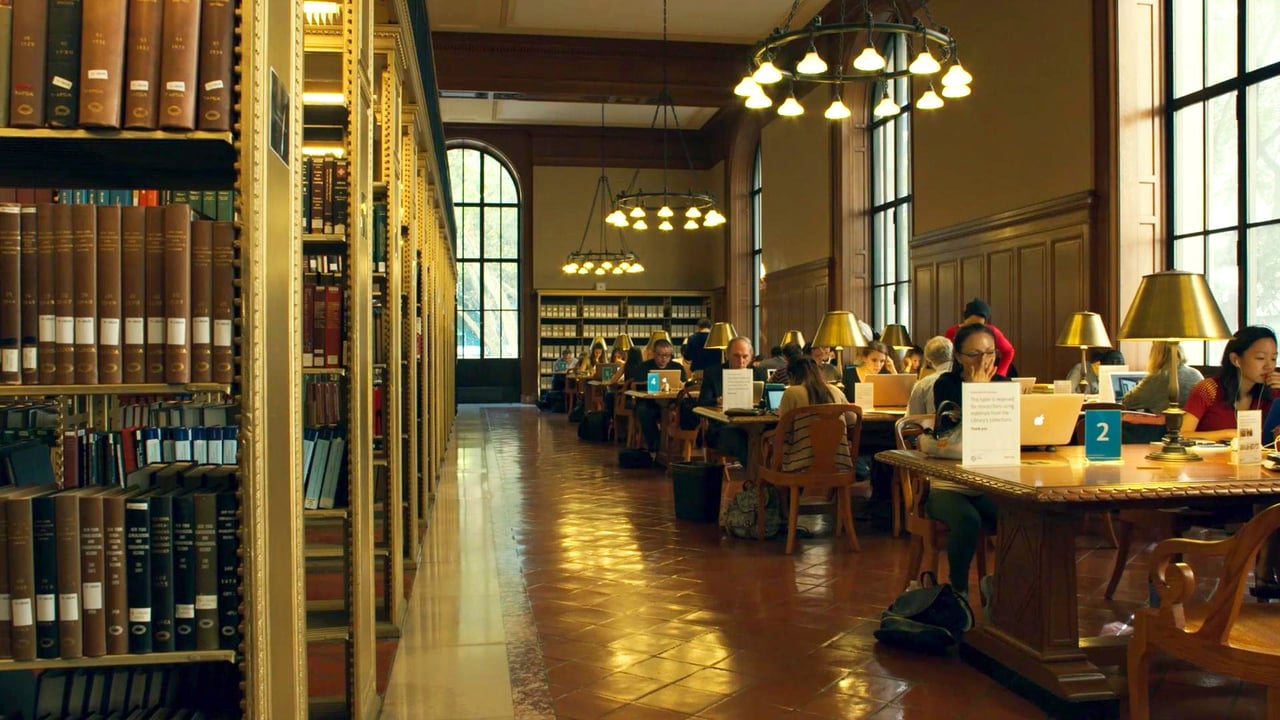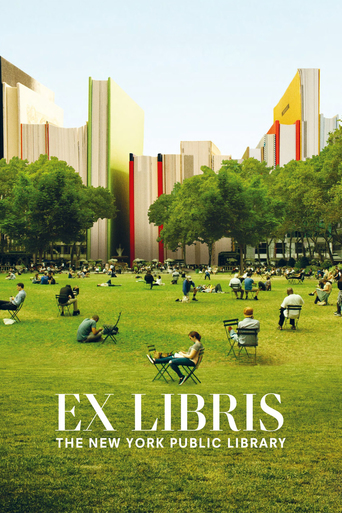

New York's various library branches are visited in all boroughs in this documentary. It includes various segments highlighting free lectures, job fairs, community gatherings, school classes, help to the needy, and library business meetings.The variety of the segments and their subjects are as well chosen as are the variety of people in each of them. For those of us who love New York and New Yorkers, the people alone make much of this film an enjoyable experience.Many of the lectures were fascinating but some seemed intended for the few with either a higher level of academic intellect and/or a great knowledge of the subject at hand. While this might have been something to overlook, it is harder to overlook the movie's biggest liability: its length of three-and-a-quarter hours. The movie could have been reduced by at least one-third.Though most of the segments were a reasonable length of time, this was not the case for the library staff meetings that were too frequent and too long - much like staff meetings for those of us in our real lives. While some moments in these scenes were interesting, they had a tendency to remind us of the occasional auditory, mental torture of our own lives - something we'd rather forget when watching a movie.
... View MoreAt over three hours, this is an epic film. It has to be because it's about an epic institution: the New York Public Library, its history, its management, its multiple branches, its global city mission, its changing nature. As usual, director Frederick Wiseman moves silently, invisibly, unobtrusively, through his subject institution. He doesn't intrude, but lets what he finds in sound and image reveal his message. Of course, a documentary is as calculated an arrangement of materials designed to make the director's point as any fiction is. But Wiseman doesn't interfere. He doesn't even make cuts within a scene or a speech. He lets the material reveal itself — though he has chosen what material to show, what message will be revealed.The frequent committee meetings make this film equally about the richness of the Library's offerings and the challenges of its governance. The Board has to work for the public's support, convince both its public and private funders to meet its needs, and balance the demands of the traditional needs with the new. Indeed, in this Library, a massive institute with responsibility for a dramatically diverse community, Wiseman finds a microcosm of America itself. Hardly any of the speakers are identified because the film is not really about them but about the institution they serve — and the national culture it represents. For the federal government has the same responsibilities of meeting the citizens' needs and generating the income to do so. But where Trump "loves the poorly educated" — to the point of trying to convert all Americans to that — the Library loves all its citizens — to the point of wanting to improve all their lives. As the studies of the users' faces reveals, the Library serves America's diversity in culture, economic class, education level, and needs. The Chinatown branch provides materials in Chinese to serve that culture and English materials to ease their assimilation. The Braille branch tapes books and teaches the blind to read. In all the branches the Library works to bring the citizens into the computer age. The Westchester branch teach kids robotics. The Bronx audience at a modern wind quartet is largely working class or unemployed, street people. The programming is not what we'd expect. Some sleep, some are simply staying warm, one woman mimes a singalong, but for each person there the music is doing some service. In the Harlem branch an impassioned poet's recital is punctuated by a baby's cries in the audience. That's life, which the artist must accommodate. So does the Library; so should the government.Bu the Republican government isn't. Time and again the speakers express a tacit resistance to the Trump administration. At a job fair, a border guard reads a statement about his job and its importance. He lacks the sincerity and warmth of the others who speak from their heart. As one speaker asserts, the library is no longer about books; it's about people. That's what the government has forgotten: it thinks it's about things, about securing personal profits, not about the citizens it is supposed to be serving. In a forceful correction to Trump, the Muslim director of the Schoenberg Institute cites the line, "The library is the pillar of democracy." In fact Muslims appear throughout the film as helpful Library stuff or citizens with the same earnest needs and care as their paler citizens. A Jewish author celebrates the Jewish immigrants and their deli tradition. This is melting pot America not our current racist paranoia.Wiseman's Library reminds us where America's greatness lies — in welcoming citizens from around the world and enabling them to make the best lives for themselves that they can. Among the most powerful correctives to current America are the speeches about the African American experience, the revival of racism, and the failure of modern capitalism to provide a fair and equal distribution of wealth. There's a lot of talk here, but it's important talk, the kind of thoughtful, articulate and constructive debate that's beyond the skill and ethics of current politics. That the Library provides the arena and the thinkers and the audience for such discussion makes it of epic importance to our future. If this New York can't save America what will?
... View MoreEX LIBRIS: NEW YORK PUBLIC LIBRARY: ENTERTAININGWhether I would last three and a half hours to watch a documentary about New York's public library was a question I asked myself when I landed in Eye Cinema (Amsterdam). So without a break.IMAGEIt went excellent. Frederick Wiseman tells you a story in such a 'zen' way that it's easy to keep looking. The beauty is: there are no voice-overs. He lets the image speak for himself.INSIGHTSYou get different insights into what happens within the walls of the central building at Bryant Park and the other locations of the library in the city New York. And that's a lot. The library organizes activities for a wide variety of audiences. The film also let you listen in on the board's conversations.NOT FOR EVERYONEFor people who love learning, books and archives, your interest is always stimulated with this film. Still, I do not think everyone will entertain themselves with Ex Libris: New York Public Library. Basically, the idea of a documentary about the public library in New York should already appeal to you, otherwise I think this film will get you bored.CONCLUDINGAn entertaining, three and a half hour documentary, for those who want to know more about the New York Public Library. Recommended.www.ongevraagdfilmadvies.com
... View MoreMaster documentarian Frederick Wiseman's latest offering is a magnum opus on the subject of the New York Public Library. If you can sit through it (as I did), it lasts an almost oppressive 3 hours and 17 minutes. Wiseman's approach is to shoot as much footage as possible and then pare it down to what he obviously regards as something "manageable." I'm not so sure that it's really manageable at all; in reality, Wiseman prefers throwing at us the proverbial "kitchen sink."A great deal of Ex Libris was shot at the iconic Stephen A. Schwarzman Building at 42nd Street and Fifth Avenue in New York City. But Wiseman also branches out to many of the local branches in the city and gives us a taste of what kind of programs one can find in these neat neighborhood "hot spots."Wiseman's approach is often lugubrious, intent on providing a multiplicity of establishing shots outside each building, before we take a peek inside. He often tarries too long on almost each special event he's covering (I was particularly annoyed by the amount of time spent covering dull board meetings chaired by administrators committed to determining policy designed to shape library offerings in the years to come).Nonetheless, if one is patient enough, there are many interesting things going on behind the scenes at the New York Public Library and Wiseman covers programs and events with aplomb. One of the most impressive offerings is the library's extraordinary picture collection, which is primarily categorized by subject matter. If you're ever in need of an image for a project you're working on, NYPL is the place to go!Wiseman reveals many facets of the vast operation that constitutes the NYPL including librarians wearing headsets, fielding questions over the phone from the public to a conveyor belt that sorts all the returned items automatically.Other fascinating activities include a laptop loaner program, a dance class for seniors, a workshop for sign language theatre interpreters, a speech by the head of the Schomberg Center (for research in Black culture) and an interview with rock star Elvis Costello.Ex Libris is a documentary worth seeing; but I just wish it was an hour shorter.
... View More